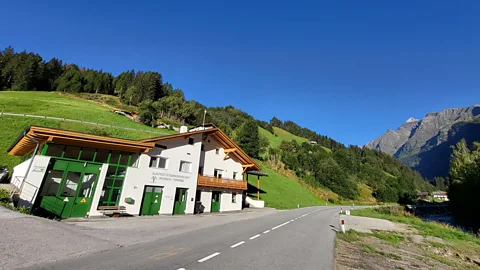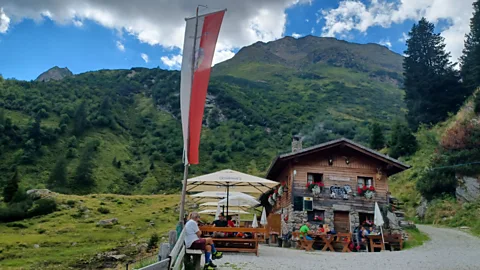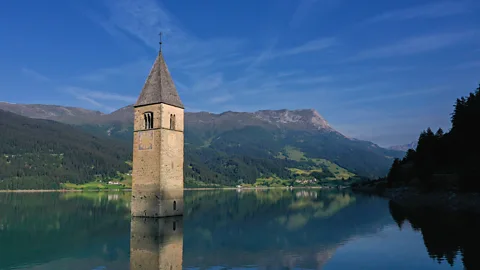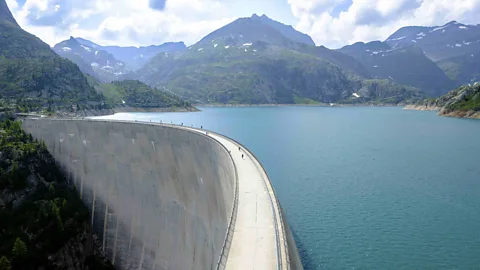The Alpine villages producing their own power
 Electricity Cooperative Pflersch
Electricity Cooperative PflerschSmall hydropower plants have long sustained remote communities in the Alps – but there is a growing debate over their environmental impact.
The Furtalm, an idyllic mountain farm in South Tyrol in the northern Italian Alps, is surrounded by waterfalls. Their rushing sound fills the air, along with the bells from a small herd of grazing cows. Hikers sit at long tables outside a tiny farm kitchen, enjoying hearty meals of homemade cheese dumplings and apple strudel. Having arrived after a bracing hike, I order a plate of dumplings, and enjoy the view over a nearby stream. Apart from looking very charming, the stream is doing me a practical favour: it is helping provide my lunch.
A tiny hydropower plant, tucked away out of sight, generates the electricity for the entire farm: enough to run the milking machine by the stable, the fridge in the dairy where the cheese is made, and all the kitchen appliances used to make my dumplings.
"Electricity is free here, it's always been that way. When it's right next to your door, you don't have an electricity counter," says Alexandra Larch, who runs the farm and restaurant with her family in the summer months, and spends the winters in the valley. Her parents have an even smaller hydro plant next to their own mountain farm: it's so tiny they have to switch off everything else in the house before they switch on the milking machine. As I enjoy my delicious dumplings, I can hear a faint clanging sound in the distance. It comes from a construction site for another hydro plant, built by a local cooperative.
South Tyrol and its Alpine neighbours are known as Europe's hydro powerhouses, mainly thanks to their large plants, which mark parts of the landscape with their valley-spanning reservoirs and giant pipes. Hydropower generates more than 7,300 gigawatt hours (GWh) a year in South Tyrol, some 90% of its total electricity production, enough to export about half of it to other Italian regions in the summer months. Over 80% of that hydropower output is generated by only 30 big plants. But in recent years, another aspect of the Alpine energy supply has been gaining increasing attention: hundreds of small hydropower plants, many rooted in traditional cultures of self-sufficiency and self-determination.
You might also like:
There are about 1,000 hydropower plants in South Tyrol, and the vast majority of them are small or medium-sized – ranging from tiny ones powering a single farm, to clusters of more sizeable ones covering an entire valley's supply. Most are run-of-river diversion plants, meaning a part of the stream is diverted, typically by small dams or weirs, through a pipe to a turbine. (There is no standard global definition of small hydro, and the upper limit can vary hugely between countries, but international reports tend to define it as up to 10 megawatt installed capacity. In South Tyrol, small typically means up to 220 kilowatt (kW) capacity, and medium, up to 3 megawatts [MW]). Elsewhere in the Alps, the picture is similar, with a multitude of small or mid-sized plants allowing individual farms or villages to be self-sufficient, while typically making a modest contribution of only around 10% or so to national hydropower production.
Advocates of small hydro present it as a relatively low-impact source of energy, with scope for global expansion. As rocketing energy prices and fears of blackouts, along with climate change, accelerate the quest to find alternatives to coal, gas and oil, the idea of a robust, renewable local energy source may sound very appealing. But critics argue that the ecological cost of small plants may be higher than previously thought – and needs to be carefully balanced against their benefits.
 Sophie Hardach
Sophie HardachA few months after my summer hike, in November, I call the Pflersch energy cooperative, which is behind the new power plant being built near the Furtalm, in the beautiful Pflersch Valley. The managing director of the cooperative, Franz Schwitzer, chuckles as he tells me that he is getting a lot of media requests these days: with the world gripped by an energy crisis, his resilient cooperative is attracting attention.
In Brief: How sustainable is small hydropower?
Historically, small hydropower helped bring electricity to many remote communities such as farms and villages in the Alps. As a legacy of this decentralised energy landscape, there are still thousands of medium-sized, small and even tiny hydropower plants in the Alps, some powering entire valleys, others, a single farm, or even, a single milking machine. New ones have also been built, based on the assumption that their environmental impact is relatively low.
However, criticism of small hydropower has been growing. There is mounting scientific evidence that their impact is larger than was previously thought, and that they can disrupt streams, damage habitats and harm migratory fish.
Although small hydropower has faced criticism, those opposing it don't necessarily rule it out altogether. Rather, a common view is that the ecological impact and social and economic benefits have to be assessed carefully, case by case.
The cooperative owns four small-to-medium-sized hydro plants in the valley, the biggest of which has an installed capacity of about 3 megawatts, as well as the one under construction. Its roughly 300 members, such as farmers, villagers, small companies and small hotels, pay only 3.1 euro cents (3.2 US cents/2.7p) per kilowatt/hour (10 euro cents/10 US cents/8.7p including taxes), up to a consumption of 1,250kWh per month. (At the time of reporting, the market price in Italy was 66 euro cents (69 US cents/57p) per kWh for the typical household, including taxes). The cooperative also supplies non-members at the market price, such as big hotels and a ski lift. For most of the year, the hydro power it generates is enough to make the Pflersch Valley self-sufficient.
"If the Italian grid were to collapse, it wouldn't be a problem for us during nine months of the year – spring, summer and autumn – given normal weather. We'd just switch our network to 'isolated operation' [for self-consumption]," says Schwitzer. In winter, the cooperative purchases additional energy from the market. If it could store the energy from the warmer months, it would be self-sufficient all year round. The community-centred model is not unusual in the region, where small firms and cooperatives are seen as adding diversity and resilience to the energy sector. According to Thomas Senoner, the director of South Tyrol's public agency for the sustainable use of water resources, part of the region's energy policy is to support rural life in the mountains, including traditional cooperatives.
To people whose lives are currently blighted by soaring energy prices, such self-sufficiency may seem like the ultimate luxury. But as Schwitzer points out, South Tyrol's cooperatives were a result of necessity, and extreme marginalisation.
The traditionally German-speaking region came under Italian rule in the early 20th Century. Some local families still harbour heartbreaking memories of the time when the central Italian government built big hydropower plants in their pristine valleys, flooding historical villages and centuries-old farms, to provide energy for Italian factories, not remote Alpine communities. Today, South Tyrol is still part of Italy but an autonomous province with control of its own energy resources.
"The cooperatives were originally created because of a disadvantage, because we were in the periphery. In the 1950s, we would never have received electricity from the main grid," says Schwitzer. "So the people said to themselves, fine, we'll do it ourselves, we'll build our own power plant. They were brave pioneers who used their private funds as collateral to take out credit and pay for the turbines. And that disadvantage of the past, has now turned into an advantage."
His cooperative has an especially long history: the local priest and three farmers started its first hydro plant in a hamlet called Boden almost 100 years ago. The priest recorded the event in his church chronicle in an awestruck tone: "14 November 1923. At 14.30 in the afternoon, Boden lit up with the glow of electric light for the very first time."
 Getty Images
Getty ImagesToday, tighter environmental regulation is making any further construction beyond the cooperative's fifth plant unlikely, says Schwitzer. He sees wind and solar power as possible options for the future of his valley, but for now, both face constraints. Wind farms have faced resistance from Alpine hiking associations. Solar panels can only be installed on roofs in South Tyrol, not as solar farms on the ground. Renovating and optimising existing hydro plants, especially the big ones, is an important step, he says. Nevertheless, in his view, small hydro shouldn't only be judged on efficiency, but also on its social role enhancing life in the mountains.
"There's a broad consensus here: the water used to generate this energy comes from our valley, and that's why we want to keep the value it creates. It's always been that way here, we organise ourselves, we're not that dependent on outside help." He compares it to the long tradition of mutual aid in bad weather and emergencies, and the tight network of volunteer-run associations, from the local orchestra to the fire brigade.
Proponents of small hydro argue that it could boost the wellbeing of many other communities around the world, too. The World Small Hydropower Development Report by the United Nations Industrial Development Organization promotes small hydropower as a "renewable and rural energy source for sustainable development". The report suggests that small hydropower could help provide power to the estimated one billion people worldwide who still do not have access to electricity.
Critics of small hydro power do tend to make an exception for remote, isolated communities. But they also emphasise that it should be used as a last resort. Cipra, an Alps-wide organisation promoting sustainable development in the area, for example recommends using small hydro plants "for limited and isolated local needs only". Using them for energy production beyond these remote areas would require such a large number of plants "that the cumulative environmental impact would be ecologically unbearable".
After all, the existing multitude of small hydro plants contributes little to the overall energy output, even in places where such plants have a long history. In Switzerland, more than 1,400 tiny, small and medium-sized hydropower plants of up to 10 MW capacity, together produce about 10% of the country's total hydropower output. In Bavaria, in Germany's mountainous south, 94% of the region's over 4,000 hydro plants have a capacity of under 1 MW, covering only about 9% of total hydropower output. In Austria, 95% of grid-connected hydro plants have a capacity of less than 10 MW, and generate about 14% of total hydropower output. There are another 2,000 or so off-grid plants in Austria, supplying private households.
 Getty Images
Getty ImagesGlobally, that imbalance between the number of small plants and their overall output is similar. Small plants represent an estimated 91% of all hydropower installations, but only make up 11% of hydropower output. And yet, they have seen a worldwide boom in recent years – as well as a growing body of evidence from around the world suggesting their impact is more profound than was previously thought.
"The biggest problem associated with small hydropower concerns their sheer numbers," says Thiago Couto, an aquatic ecologist and postdoctoral associate at the University of Miami. He has studied the effects of small hydropower plants around the world, including in countries such as Brazil. "Today, for every large hydropower dam operating there are other 11 'small' ones, and their numbers are expected to continue rising into the future. The cumulative impact of all these small dams on hydrology, fish migration and water quality is an issue of high concern, especially in rivers that accommodate multiple dams."
Small hydropower dams may for example play a disproportionate role in interrupting the natural flow of rivers, known as river fragmentation, research by Couto and others shows. This can prevent migratory fish from travelling. Environmental activists have described the impact of such an accumulation of small, disruptive plants on rivers as "death by a thousand cuts".
From an environmental perspective, "small" is not a particularly meaningful term, Couto notes, since it usually just refers to generation capacity – rather than to factors that actually matter for the plant's ecological impact, such as how much water is diverted, and how much remains in the stream bed. And while small hydropower is often marketed as a good solution for unconnected communities, globally, "the proliferation of small hydropower is not being primarily propelled by rural electrification," he says, but rather, by incentives and subsidies that make it a lucrative investment for businesses.
Nor are remote communities necessarily in favour of small hydropower. Sámi reindeer herders in northern Norway have opposed small hydropower development in the past, out of concern over its impact on reindeer pastures.
Scientists have also pointed to the knowledge gap around small hydro, since they are only beginning to fully understand how different factors affect a plant's overall impact.
A team of scientists conducting a long-term ecological research project in the Matschertal valley (Val di Mazia), led by the Institute for Alpine Environment at the Eurac Research Center in South Tyrol, made a surprising discovery. Their project's main aim has been to study the impact of climate change on an Alpine river ecosystem. But a few years into the study, a small run-of-river diversion hydropower plant with a weir was added to the steep, glacier-fed, fast-flowing stream they were monitoring. They used the opportunity to make a before-and-after comparison of the plant's impact on benthic macroinvertebrates – small aquatic animals such as stonefly larvae that live in waterbodies, and are commonly used as indicators of their ecological condition. They expected the plant to have a significant impact on the macroinvertebrates – but those expectations were not confirmed.
Instead, the results of the five-year study showed "no significant variation in the benthic macroinvertebrate communities stemming from the activity of the hydropower plant". A second study looking specifically at the functional traits of the macroinvertebrates before and after the plant's installation – meaning, how they interacted with their environment and with other species – and did not find any significant differences, either.
"One really important point is that there are no fish in this particular part of the river," says Roberta Bottarin, a limnologist and the vice head of the Institute for Alpine Environment at Eurac, who co-authored the study. "If there had been fish, we would probably have had very different results." In her view, other factors, including the relatively large amount of water left in the original stream, may also have helped buffer the impact of the plant.
Still, she cautions against interpreting the results as a green light for small hydropower in the high mountains, emphasising that the team only measured the impact on the macroinvertebrates, not on the wider ecosystem. "From an ecological point of view, these high mountain streams are very sensitive. And if you build a plant there, you risk disrupting that ecological continuity and disturbing the natural balance. It's really something you have to weigh very carefully."
 Sophie Hardach
Sophie HardachThat tricky balance should, however, also take into account the energy needs of mountain communities, in her opinion: "Sustainable doesn't only mean ecological, it also includes social and economic factors. That's really important, and has to be considered," she says. "When there's no other option, you have to accept a compromise, and try and make it as ecologically acceptable as possible, for example by ensuring that enough water remains in the stream."
Carbon Count
The emissions from travel it took to report this story were 0kg CO2, given Sophie was already in South Tyrol for reasons other than this reporting assignment. The digital emissions from this story are an estimated 1.2g to 3.6g CO2 per page view. Find out more about how we calculated this figure here.
Asked whether one should consider social and economic factors when assessing the impact of small hydropower, such as the needs of remote communities in the Alps, Christine Weber, a river ecologist at the Swiss Federal Institute of Aquatic Science and Technology (Eawag), says: "That is a difficult question. I tend to say that a case-by-case assessment is needed where the bigger picture is looked at," meaning, the ecological impact on the whole river basin.
A 2018 review by Weber and others analysed evidence on this basin-scale impact, which can include sediment clogging the stream bed, a poorer habitat for fish, and a negative effect on fish populations. According to the review, the small hydropower boom is "exacerbating ongoing habitat fragmentation and degradation, and further fuelling biodiversity loss".
Others have voiced similar warnings. Environmental organisations, for example in Austria, have raised concerns. German scientists have spoken out against small hydro plants in an open letter, describing them as a "renewable but not necessarily environmentally friendly" source of energy.
Looking back at my delightful Alpine dumpling lunch, powered by mini hydro, I reflect on my own role in this energy dilemma. Tourism is an important part of the South Tyrolean economy, and provides communities with a local source of income – but there is no doubt that I and my fellow tourists are also putting additional pressure on local energy sources. And saving energy is probably easier for a tourist with no chores and plenty of leisure time, than a farmer with cows to milk and cheese to refrigerate. I resolve to make any future Alpine holidays as energy-saving as possible. Keeping my footprint modest is, perhaps, a small contribution I can make to help the people of the Alps preserve their lovely part of the world for future generations.
--
If you liked this story, sign up for the weekly bbc.com features newsletter, called "The Essential List" – a handpicked selection of stories from BBC Future, Culture, Worklife, Travel and Reel delivered to your inbox every Friday.
